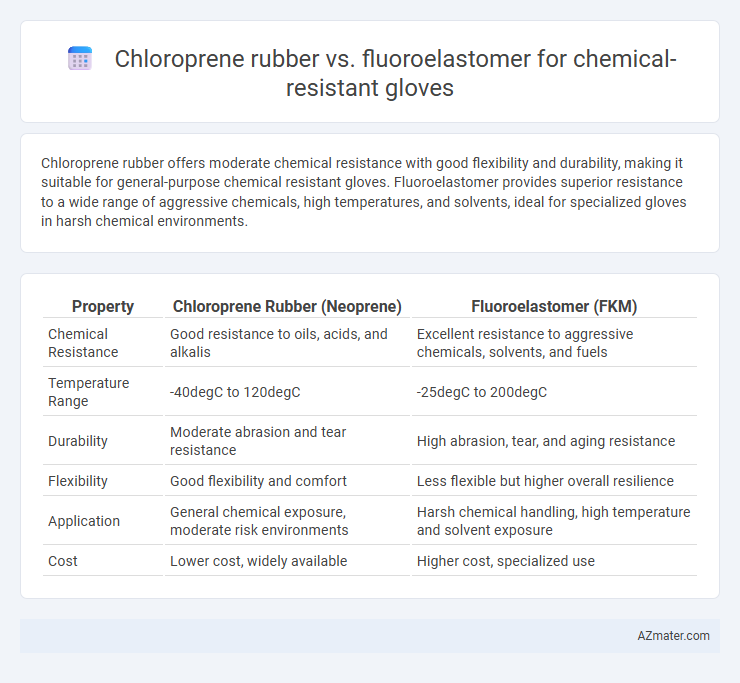Chloroprene rubber offers moderate chemical resistance with good flexibility and durability, making it suitable for general-purpose chemical resistant gloves. Fluoroelastomer provides superior resistance to a wide range of aggressive chemicals, high temperatures, and solvents, ideal for specialized gloves in harsh chemical environments.
Table of Comparison
| Property | Chloroprene Rubber (Neoprene) | Fluoroelastomer (FKM) |
|---|---|---|
| Chemical Resistance | Good resistance to oils, acids, and alkalis | Excellent resistance to aggressive chemicals, solvents, and fuels |
| Temperature Range | -40degC to 120degC | -25degC to 200degC |
| Durability | Moderate abrasion and tear resistance | High abrasion, tear, and aging resistance |
| Flexibility | Good flexibility and comfort | Less flexible but higher overall resilience |
| Application | General chemical exposure, moderate risk environments | Harsh chemical handling, high temperature and solvent exposure |
| Cost | Lower cost, widely available | Higher cost, specialized use |
Overview of Chemical Resistant Gloves
Chemical resistant gloves made from chloroprene rubber offer excellent resistance to a wide range of chemicals, including acids, alkalis, and solvents, making them suitable for various industrial applications. Fluoroelastomer gloves provide superior protection against aggressive chemicals such as oils, fuels, and harsh solvents, excelling in high-temperature environments and extended chemical exposure. The choice between chloroprene and fluoroelastomer materials depends on specific chemical exposure, temperature requirements, and durability needed for optimal safety and performance.
Introduction to Chloroprene Rubber
Chloroprene rubber, also known as neoprene, exhibits excellent chemical resistance, making it a preferred material for protective gloves in various industrial applications. Its balanced properties include resistance to oils, acids, and alkalis, combined with strong physical durability and flexibility at low temperatures. Compared to fluoroelastomers, chloroprene offers cost-effective protection with good overall chemical resistance, though it may have limitations against highly aggressive solvents.
Introduction to Fluoroelastomer
Fluoroelastomer gloves offer superior chemical resistance compared to chloroprene rubber, making them ideal for handling aggressive chemicals like solvents, acids, and fuels. Their unique fluorine-based polymer structure provides excellent resistance to heat, oils, and oxidation, significantly enhancing durability in harsh environments. These gloves are preferred in industries such as aerospace, automotive, and chemical processing due to their robust protection and long service life.
Chemical Resistance Comparison
Chloroprene rubber exhibits strong resistance to acids, oils, and alkalis, making it suitable for general chemical handling, but it may degrade when exposed to aromatic and chlorinated solvents. Fluoroelastomers offer superior chemical resistance across a broader spectrum, including aggressive fuels, oils, ketones, and aromatic hydrocarbons, ensuring enhanced durability in harsh chemical environments. For chemical resistant gloves, fluoroelastomer materials provide prolonged protection against aggressive chemicals and solvents, outperforming chloroprene in demanding industrial applications.
Mechanical Properties and Durability
Chloroprene rubber offers excellent mechanical properties with high tensile strength and good flexibility, making it resistant to abrasion and tearing in chemical-resistant gloves. Fluoroelastomer provides superior chemical resistance, especially against oils, fuels, and solvents, while maintaining exceptional durability and heat resistance. Both materials enhance glove longevity, but fluoroelastomer excels in harsh chemical environments with prolonged exposure, whereas chloroprene rubber balances strength and flexibility for moderate chemical protection.
Temperature Performance
Chloroprene rubber offers chemical resistant gloves with effective temperature performance ranging from -40degC to 120degC, making it suitable for moderate heat applications. Fluoroelastomer gloves excel in high-temperature environments with resistance up to 200degC, providing superior protection in extreme thermal and chemical exposure. The choice between these materials depends on the required thermal endurance and chemical compatibility for specific industrial uses.
Comfort and Fit Considerations
Chloroprene rubber gloves offer excellent flexibility and a softer texture, enhancing comfort and fit during prolonged use, making them ideal for tasks requiring dexterity. Fluoroelastomer gloves provide superior chemical resistance but tend to be less elastic, which can lead to a tighter fit and reduced comfort in extended wear. The choice between these materials depends on balancing the need for chemical protection with ergonomic factors like glove flexibility and user fatigue.
Industry Applications
Chloroprene rubber offers excellent resistance to oils, acids, and caustic solutions, making it ideal for automotive, chemical processing, and general industrial applications requiring moderate chemical protection. Fluoroelastomer gloves provide superior resistance to a wider range of aggressive chemicals, including solvents, fuels, and high-temperature fluids, which makes them indispensable in aerospace, petrochemical, and pharmaceutical industries. The selection between chloroprene rubber and fluoroelastomer depends on the specific chemical exposure, temperature range, and durability requirements unique to each industry environment.
Cost and Availability
Chloroprene rubber offers a more cost-effective solution compared to fluoroelastomer for chemical-resistant gloves, making it a preferred choice in industries with budget constraints. Availability of chloroprene rubber gloves is generally higher due to more established manufacturing processes and widespread use. Fluoroelastomer gloves, while superior in chemical resistance against aggressive solvents and high temperatures, tend to be significantly more expensive and less readily stocked by suppliers.
Choosing the Right Glove Material
Chloroprene rubber offers excellent resistance to a broad range of chemicals, including oils, acids, and alkalis, making it ideal for general-purpose chemical-resistant gloves. Fluoroelastomer provides superior protection against aggressive solvents, hydrocarbons, and high-temperature chemicals, suitable for specialized industrial applications requiring maximum chemical resistance. Selecting the right glove material depends on the specific chemical exposure, temperature requirements, and durability needed for the workplace environment.

Infographic: Chloroprene rubber vs Fluoroelastomer for Chemical resistant glove
 azmater.com
azmater.com